三聚氰胺msds
- 格式:pdf
- 大小:27.76 KB
- 文档页数:5

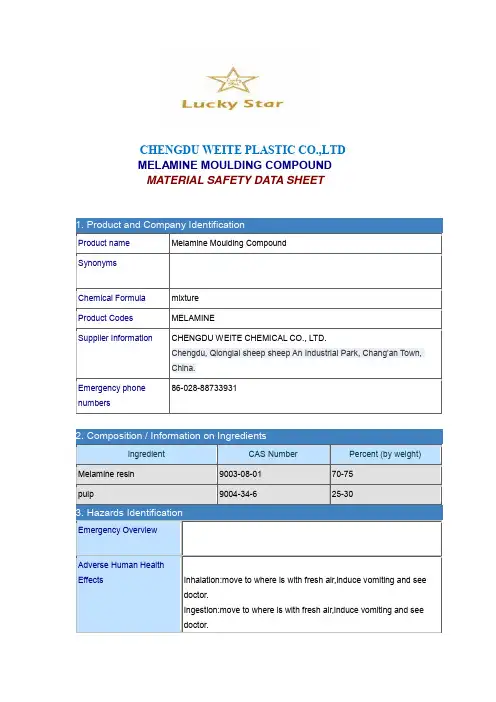

三聚氰胺调研报告白色粉末三聚氰胺含量:≥99.8%水分含量:≤0.15%灰分含量:≤0.03%铁含量:≤3mg/kgpH值:7.5-9.5四、安全性三聚氰胺是一种低毒、不易吸收的化合物,但长期接触可能会对皮肤和眼睛造成刺激。
在生产和使用过程中,应注意防护措施,避免吸入粉尘和接触皮肤。
如不慎接触,应立即用大量清水冲洗,并咨询医生。
五、结论三聚氰胺是一种重要的有机化工中间体,在生产和生活中有广泛的应用。
在使用过程中,应注意安全防护,避免对人体和环境造成危害。
未来,随着科技的发展和需求的不断增加,三聚氰胺的应用领域将会更加广泛。
三聚氰胺是一种重要的化学品,主要用于生产树脂、胶粘剂、纤维、涂料等产品。
其质量指标包括三聚氰胺含量、水份含量、灰份含量、色度(铂-钴号)、浊度(高岭土)、PH值和水溶性等。
优质的三聚氰胺应为白色粉末,无杂物混入,三聚氰胺含量≥99.8%,水份含量≤0.10%,灰份含量≤0.03%,色度(铂-钴号)≤20,浊度(高岭土)≤20,PH值在7.5~9.5之间,水溶性<20℃或<25℃。
在市场前景方面,我国三聚氰胺的生产速度非常快,已成为世界上发展速度最快的国家之一。
根据统计数据显示,2007年世界三聚氰胺生产能力达到156.9万吨,产量达到122.6万吨,消费量达到122.5万吨。
预计2012年世界三聚氰胺生产能力将达到190万吨/年左右,2017年将达到220万吨/年左右。
预计2007-2012年间,世界三聚氰胺消费将以年4.8%的速度增长,2012年世界三聚氰胺需求量将达到155万吨。
预计2017年世界三聚氰胺需求量将达到188万吨左右。
在国内方面,我国已成为世界三聚氰胺产能与产量最大的国家,国内三聚氰胺有效生产能力约76万吨,产量50.6万吨,占世界总产能的48.4%。
预计2012年,国内三聚氰胺生产能力将达到100万吨,2017年将达到130万吨。
根据三聚氰胺下游相关应用领域的发展分析,预计2007-2012年年均需求增长率为7.8%,2012年国内三聚氰胺需求量达到56万吨;预计2012-2017年年均需求增长率为6%,2017年需求量将达到75万吨左右。

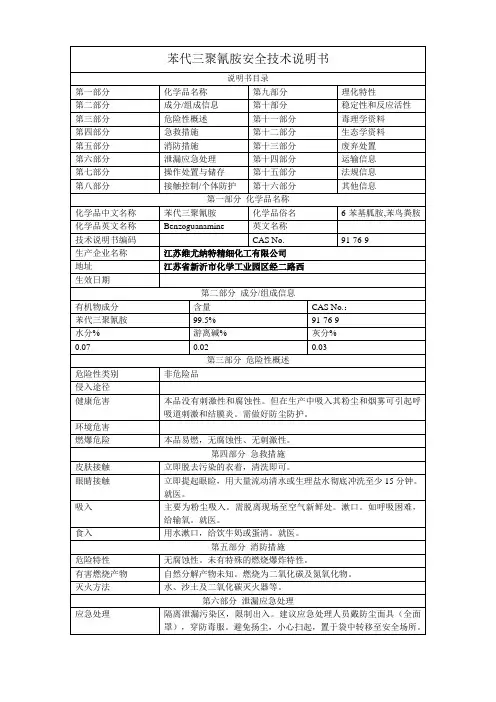
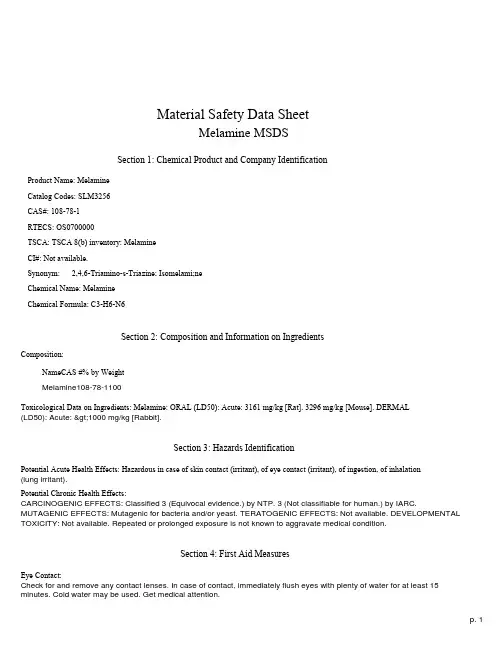
Material Safety Data SheetMelamine MSDSSection 1: Chemical Product and Company IdentificationProduct Name: MelamineCatalog Codes: SLM3256CAS#: 108-78-1RTECS: OS0700000TSCA: TSCA 8(b) inventory: MelamineCI#: Not available.Synonym: 2,4,6-Triamino-s-Triazine; Isomelami;neChemical Name: MelamineChemical Formula: C3-H6-N6Section 2: Composition and Information on IngredientsComposition:NameCAS #% by WeightMelamine108-78-1100Toxicological Data on Ingredients: Melamine: ORAL (LD50): Acute: 3161 mg/kg [Rat]. 3296 mg/kg [Mouse]. DERMAL(LD50): Acute: >1000 mg/kg [Rabbit].Section 3: Hazards IdentificationPotential Acute Health Effects: Hazardous in case of skin contact (irritant), of eye contact (irritant), of ingestion, of inhalation(lung irritant).Potential Chronic Health Effects:CARCINOGENIC EFFECTS: Classified 3 (Equivocal evidence.) by NTP. 3 (Not classifiable for human.) by IARC. MUTAGENIC EFFECTS: Mutagenic for bacteria and/or yeast. TERATOGENIC EFFECTS: Not available. DEVELOPMENTAL TOXICITY: Not available. Repeated or prolonged exposure is not known to aggravate medical condition.Section 4: First Aid MeasuresEye Contact:Check for and remove any contact lenses. In case of contact, immediately flush eyes with plenty of water for at least 15 minutes. Cold water may be used. Get medical attention.Skin Contact:In case of contact, immediately flush skin with plenty of water. Cover the irritated skin with an emollient. Remove contaminated clothing and shoes. Cold water may be used.Wash clothing before reuse. Thoroughly clean shoes before reuse. Get medical attention.Serious Skin Contact:Wash with a disinfectant soap and cover the contaminated skin with an anti-bacterial cream. Seek immediate medical attention.Inhalation:If inhaled, remove to fresh air. If not breathing, give artificial respiration. If breathing is difficult, give oxygen. Get medical attention.Serious Inhalation: Not available.Ingestion:Do NOT induce vomiting unless directed to do so by medical personnel. Never give anything by mouth to an unconscious person. Loosen tight clothing such as a collar, tie, belt or waistband. Get medical attention if symptoms appear.Serious Ingestion: Not available.Section 5: Fire and Explosion DataFlammability of the Product: May be combustible at high temperature.Auto-Ignition Temperature: Not available.Flash Points: CLOSED CUP: Higher than 93.3°C (200°F).Flammable Limits: Not available.Products of Combustion:These products are carbon oxides (CO, CO2), nitrogen oxides (NO, NO2...), cyanide fumes, irritating and toxic fumes and gases.Fire Hazards in Presence of Various Substances: Slightly flammable to flammable in presence of heat.Explosion Hazards in Presence of Various Substances:Risks of explosion of the product in presence of mechanical impact: Not available. Risks of explosion of the product in presence of static discharge: Not available.Fire Fighting Media and Instructions:SMALL FIRE: Use DRY chemical powder. LARGE FIRE: Use water spray, fog or foam. Do not use water jet.Special Remarks on Fire Hazards: Not available.Special Remarks on Explosion Hazards: Not available.Section 6: Accidental Release MeasuresSmall Spill:Use appropriate tools to put the spilled solid in a convenient waste disposal container. Finish cleaning by spreading water on the contaminated surface and dispose of according to local and regional authority requirements.Large Spill:Use a shovel to put the material into a convenient waste disposal container. Finish cleaning by spreading water on the contaminated surface and allow to evacuate through the sanitary system.Section 7: Handling and StoragePrecautions:Keep locked up.. Keep away from heat. Keep away from sources of ignition. Empty containers pose a fire risk, evaporate the residue under a fume hood. Ground all equipment containing material. Do not ingest. Do not breathe dust. Wear suitable protective clothing. In case of insufficient ventilation, wear suitable respiratory equipment. If ingested, seek medical advice immediately and show the container or the label. Avoid contact with skin and eyes. Keep away from incompatibles such as oxidizing agents, acids.Storage: Keep container tightly closed. Keep container in a cool, well-ventilated area. Do not store above 23°C (73.4°F).Section 8: Exposure Controls/Personal ProtectionEngineering Controls:Use process enclosures, local exhaust ventilation, or other engineering controls to keep airborne levels below recommended exposure limits. If user operations generate dust, fume or mist, use ventilation to keep exposure to airborne contaminants below the exposure limit.Personal Protection:Splash goggles. Lab coat. Dust respirator. Be sure to use an approved/certified respirator or equivalent. Gloves.Personal Protection in Case of a Large Spill:Splash goggles. Full suit. Dust respirator. Boots. Gloves. A self contained breathing apparatus should be used to avoid inhalation of the product. Suggested protective clothing might not be sufficient; consult a specialist BEFORE handling this product.Exposure Limits: Not available.Section 9: Physical and Chemical PropertiesPhysical state and appearance: Solid. (Crystalline solid.)Odor: Not available.Taste: Not available.Molecular Weight: 126.12 g/moleColor: White.pH (1% soln/water): Not available.Boiling Point: Not available.Melting Point: <250°C (482°F)Critical Temperature: Not available.Specific Gravity: 1.573 (Water = 1)Vapor Pressure: Not applicable.Vapor Density: 4.34 (Air = 1)Volatility: Not available.Odor Threshold: Not available.Water/Oil Dist. Coeff.: Not available.Ionicity (in Water): Not available.Dispersion Properties: See solubility in water.Solubility:Partially soluble in cold water. Insoluble in diethyl ether.Section 10: Stability and Reactivity DataStability: The product is stable.Instability Temperature: Not available.Conditions of Instability: Dust generation, excess heat, incompatible materials.Incompatibility with various substances: Reactive with oxidizing agents, acids.Corrosivity: Not available.Special Remarks on Reactivity: Not available.Special Remarks on Corrosivity: Not available.Polymerization: Will not occur.Section 11: Toxicological InformationRoutes of Entry: Inhalation. Ingestion.Toxicity to Animals:Acute oral toxicity (LD50): 3161 mg/kg [Rat]. Acute dermal toxicity (LD50): >1000 mg/kg [Rabbit].Chronic Effects on Humans:CARCINOGENIC EFFECTS: Classified 3 (Equivocal evidence.) by NTP. 3 (Not classifiable for human.) by IARC. MUTAGENIC EFFECTS: Mutagenic for bacteria and/or yeast.Other Toxic Effects on Humans: Hazardous in case of skin contact (irritant), of ingestion, of inhalation (lung irritant).Special Remarks on Toxicity to Animals: Not available.Special Remarks on Chronic Effects on Humans:May cause adverse reproductive effects (fertility, fetotoxicity), and may affect genetic material based on animal data. May also be tumorigenic (carcinogenic) based on animal data.Special Remarks on other Toxic Effects on Humans:Acute Potential Health Effects: Skin: May cause skin irritation. Eyes: May cause eye irritation. Inhalation: May cause irritation of the respiratory tract and affect respiration. May affect behavior and sense organs, liver and blood. Ingestion: May cause irritation of the digestive tract with nausea, vomiting and diarrhea. May affect the urinary system.Section 12: Ecological InformationEcotoxicity: Not available.BOD5 and COD: Not available.Products of Biodegradation:Possibly hazardous short term degradation products are not likely. However, long term degradation products may arise. Toxicity of the Products of Biodegradation: The products of degradation are less toxic than the product itself.Special Remarks on the Products of Biodegradation: Not available.Section 13: Disposal ConsiderationsWaste Disposal:Waste must be disposed of in accordance with federal, state and local environmental control regulations.Section 14: Transport InformationDOT Classification: Not a DOT controlled material (United States).Identification: Not applicable.Special Provisions for Transport: Not applicable.Section 15: Other Regulatory InformationFederal and State Regulations:Pennsylvania RTK: Melamine Massachusetts RTK: Melamine New Jersey: Melamine TSCA 8(b) inventory: MelamineOther Regulations: EINECS: This product is on the European Inventory of Existing Commercial Chemical Substances.Other Classifications:WHMIS (Canada): Not controlled under WHMIS (Canada).DSCL (EEC):R36/37/38- Irritating to eyes, respiratory system and skin. S24/25- Avoid contact with skin and eyes. S36/37/39- Wear suitable protective clothing, gloves and eye/face protection.HMIS (U.S.A.):Health Hazard: 2Fire Hazard: 1Reactivity: 0Personal Protection: ENational Fire Protection Association (U.S.A.):Health: 2Flammability: 1Reactivity: 0Specific hazard:Protective Equipment:Gloves. Lab coat. Dust respirator. Be sure to use an approved/certified respirator or equivalent. Splash goggles.Section 16: Other InformationReferences: Not available.Other Special Considerations: Not available.The information above is believed to be accurate and represents the best information currently available to us. However, wemake no warranty of merchantability or any other warranty, express or implied, with respect to such information, and we assumeno liability resulting from its use. Users should make their own investigations to determine the suitability of the information fortheir particular purposes.。
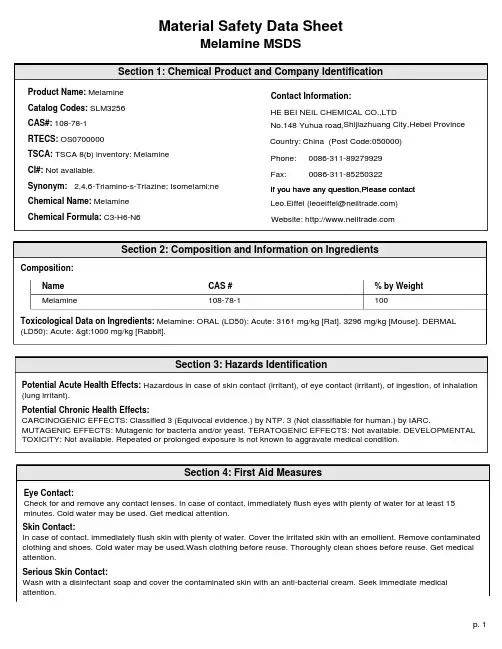
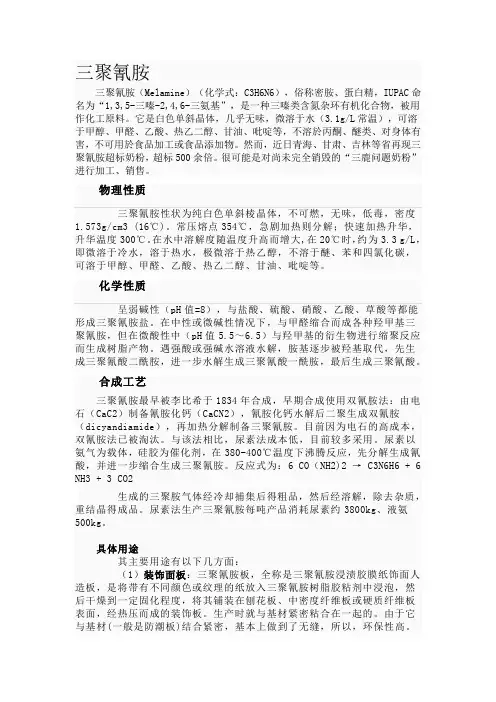
三聚氰胺三聚氰胺(Melamine)(化学式:C3H6N6),俗称密胺、蛋白精,IUPAC命名为“1,3,5-三嗪-2,4,6-三氨基”,是一种三嗪类含氮杂环有机化合物,被用作化工原料。
它是白色单斜晶体,几乎无味,微溶于水(3.1g/L常温),可溶于甲醇、甲醛、乙酸、热乙二醇、甘油、吡啶等,不溶於丙酮、醚类、对身体有害,不可用於食品加工或食品添加物。
然而,近日青海、甘肃、吉林等省再现三聚氰胺超标奶粉,超标500余倍。
很可能是对尚未完全销毁的“三鹿问题奶粉”进行加工、销售。
物理性质三聚氰胺性状为纯白色单斜棱晶体,不可燃,无味,低毒,密度1.573g/cm3 (16℃)。
常压熔点354℃,急剧加热则分解;快速加热升华,升华温度300℃。
在水中溶解度随温度升高而增大,在20℃时,约为3.3 g/L,即微溶于冷水,溶于热水,极微溶于热乙醇,不溶于醚、苯和四氯化碳,可溶于甲醇、甲醛、乙酸、热乙二醇、甘油、吡啶等。
化学性质呈弱碱性(pH值=8),与盐酸、硫酸、硝酸、乙酸、草酸等都能形成三聚氰胺盐。
在中性或微碱性情况下,与甲醛缩合而成各种羟甲基三聚氰胺,但在微酸性中(pH值5.5~6.5)与羟甲基的衍生物进行缩聚反应而生成树脂产物。
遇强酸或强碱水溶液水解,胺基逐步被羟基取代,先生成三聚氰酸二酰胺,进一步水解生成三聚氰酸一酰胺,最后生成三聚氰酸。
合成工艺三聚氰胺最早被李比希于1834年合成,早期合成使用双氰胺法:由电石(CaC2)制备氰胺化钙(CaCN2),氰胺化钙水解后二聚生成双氰胺(dicyandiamide),再加热分解制备三聚氰胺。
目前因为电石的高成本,双氰胺法已被淘汰。
与该法相比,尿素法成本低,目前较多采用。
尿素以氨气为载体,硅胶为催化剂,在380-400℃温度下沸腾反应,先分解生成氰酸,并进一步缩合生成三聚氰胺。
反应式为:6 CO(NH2)2 → C3N6H6 + 6 NH3 + 3 CO2生成的三聚胺气体经冷却捕集后得粗品,然后经溶解,除去杂质,重结晶得成品。
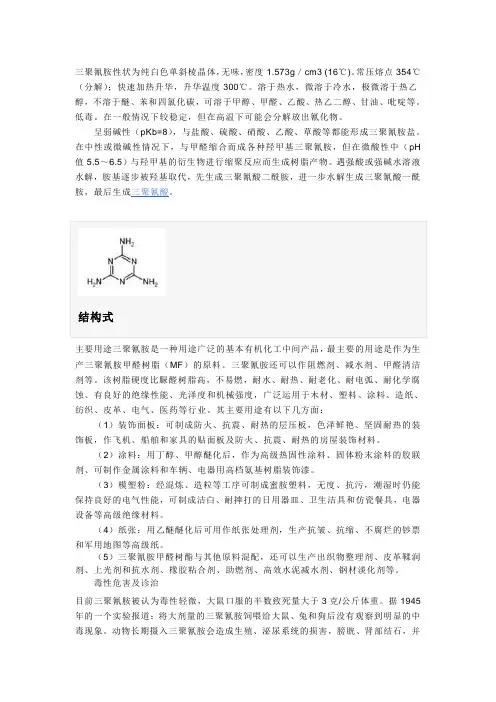
三聚氰胺性状为纯白色单斜棱晶体,无味,密度1.573g/cm3 (16℃)。
常压熔点354℃(分解);快速加热升华,升华温度300℃。
溶于热水,微溶于冷水,极微溶于热乙醇,不溶于醚、苯和四氯化碳,可溶于甲醇、甲醛、乙酸、热乙二醇、甘油、吡啶等。
低毒。
在一般情况下较稳定,但在高温下可能会分解放出氰化物。
呈弱碱性(pKb=8),与盐酸、硫酸、硝酸、乙酸、草酸等都能形成三聚氰胺盐。
在中性或微碱性情况下,与甲醛缩合而成各种羟甲基三聚氰胺,但在微酸性中(pH 值5.5~6.5)与羟甲基的衍生物进行缩聚反应而生成树脂产物。
遇强酸或强碱水溶液水解,胺基逐步被羟基取代,先生成三聚氰酸二酰胺,进一步水解生成三聚氰酸一酰胺,最后生成三聚氰酸。
主要用途三聚氰胺是一种用途广泛的基本有机化工中间产品,最主要的用途是作为生产三聚氰胺甲醛树脂(MF)的原料。
三聚氰胺还可以作阻燃剂、减水剂、甲醛清洁剂等。
该树脂硬度比脲醛树脂高,不易燃,耐水、耐热、耐老化、耐电弧、耐化学腐蚀、有良好的绝缘性能、光泽度和机械强度,广泛运用于木材、塑料、涂料、造纸、纺织、皮革、电气、医药等行业。
其主要用途有以下几方面:(1)装饰面板:可制成防火、抗震、耐热的层压板,色泽鲜艳、坚固耐热的装饰板,作飞机、船舶和家具的贴面板及防火、抗震、耐热的房屋装饰材料。
(2)涂料:用丁醇、甲醇醚化后,作为高级热固性涂料、固体粉末涂料的胶联剂、可制作金属涂料和车辆、电器用高档氨基树脂装饰漆。
(3)模塑粉:经混炼、造粒等工序可制成蜜胺塑料,无度、抗污,潮湿时仍能保持良好的电气性能,可制成洁白、耐摔打的日用器皿、卫生洁具和仿瓷餐具,电器设备等高级绝缘材料。
(4)纸张:用乙醚醚化后可用作纸张处理剂,生产抗皱、抗缩、不腐烂的钞票和军用地图等高级纸。
(5)三聚氰胺甲醛树酯与其他原料混配,还可以生产出织物整理剂、皮革鞣润剂、上光剂和抗水剂、橡胶粘合剂、助燃剂、高效水泥减水剂、钢材淡化剂等。
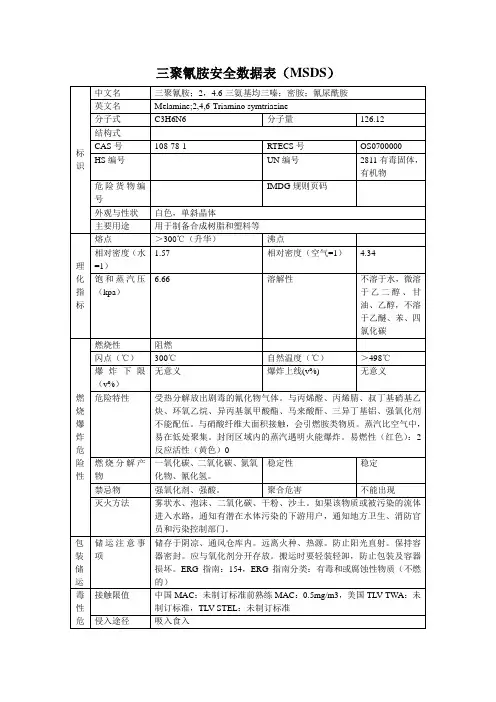

三聚氰胺简单介绍
三聚氰胺(Melamine,108-78-1)是一种有机碱,是具有1、3、5-三嗪骨架的氰胺三聚体。
像氰酰胺一样,三聚氰胺含有66%的氮,如果与树脂混合,由于在燃烧或炭化时会释放出氮气,因此具有阻燃性,并具有其他工业用途。
三聚氰胺也是农药嘧啶嗪的代谢产物。
它是在摄入环丙嗪的哺乳动物体内形成的。
三聚氰胺也进入了三聚氰胺多磺酸盐的生产过程,三聚氰胺多磺酸盐被用作高效减水剂,用于制造高强度混凝土。
三聚氰胺(108-78-1,Melamine)能升华, 呈弱碱性, 溶于热水,微溶于冷水,极微溶于热乙醇,不溶于乙醚、四氯化碳和苯,致死量(小鼠,经口)1600mg/kg,有刺激性,有致癌可能性.。
三聚氰胺旳性质及检测措施2023级食工一班郭佳 11 三聚氰胺旳理化性质三聚氰胺(英文: Melamine)分子式为C3H6N6,分子量为126.12,俗称密胺、蛋白精, IUPAC命名为“1,3,5-三嗪-2,4,6-三胺”, 是一种三嗪类含氮杂环有机化合物, 为白色单斜晶体,无毒、无味,不可燃烧,可溶于甲醇、甲醛、乙酸、甘油及吡啶等,微溶于水、乙醇,不溶于苯、乙醚、四氯化碳。
相对密度为1.573g/cm3,熔点为354℃高温下可分解产生含氢化氰、氮氧化物和氨等有毒和刺激性旳烟雾。
三聚氰胺呈弱碱性,在中性或弱碱性环境下能与甲醛缩合形成多种羟甲基三聚氰胺,但在微酸性(pH值5.5~6.5)环境下,可以与羟甲基旳衍生物进行缩聚反应而生成树脂产物。
此外,三聚氰胺三种同系物:三聚氰酸、三聚氰酸一酰胺和三聚氰酸二酰胺。
三聚氰胺是一种用途十分广泛旳有机化工原料, 对身体有害, 不可用于食品加工或食品添加物。
三聚氰胺部分物理性质:熔点(℃): >300(升华)相对密度(水=1): 1.573相对蒸气密度(空气=1): 4.34饱和蒸气压(kPa): 6.66水中溶解度(20℃): 0.33g2 三聚氰胺旳毒性动物长期摄入三聚氰胺会导致生殖、泌尿系统旳损害,膀胱、肾部出现结石,并可深入诱发膀胱癌对于肾脏, 短期高浓度接触后会引起肾结石、急性肾衰, 长期接触还会导致肾脏组织损伤。
三聚氰胺同系物具有三聚氰胺同样旳毒性效应,诸多研究都将它们作为三聚氰胺复合物(MCs)进行总体毒理学评价。
3 第一法高效液相色谱法(HPLC)3.1 原理试样用三氯乙酸溶液-乙腈提取, 经阳离子互换固相萃取柱净化后, 用高效液相色谱测定, 外标法定量。
3.2 试剂与材料除非另有阐明, 所有试剂均为分析纯, 水为GB/T 6682规定旳一级水。
甲醇乙腈氨水三氯乙酸辛烷磺酸钠甲醇水溶液三氯乙酸溶液(1%)氨化甲醇溶液(5%)离子对试剂缓冲液三聚氰胺原则品三聚氰胺原则储备液阳离子互换固相萃取柱定性滤纸海砂微孔滤膜氮气3.3 仪器和设备高效液相色谱(HPLC)仪分析天平离心机超声波水浴固相萃取装置氮气吹干仪涡旋混合器具塞塑料离心管3.4 样品处理3.4.1 提取3.4.1.1 液态奶、奶粉、酸奶、冰淇淋和奶糖等称取2 g(精确至0.01 g)试样于50 mL具塞塑料离心管中, 加入15 mL 三氯乙酸溶液和5 mL 乙腈, 超声提取10 min, 再振荡提取10 min后, 以不低于4000 r/min离心10 min。
氰尿酸化学品安全技术说明书(MSDS)第一部分:化学品名称化学品中文名称:三聚氰酸化学品英文名称:cyanuric acid中文别名:英文别名:技术说明书编码:分子式:C 3 H 3 N 3 O 3分子量:129.08第二部分:成分/组成信息主要成分:纯品CAS No.:108-80-5第三部分:危险性概述危险性类别:侵入途径:健康危害:目前尚未见职业中毒报道。
需注意浓溶液中分解产生NCl3及加热时产生氰酸时的危害。
环境危害:燃爆危险:第四部分:急救措施皮肤接触:脱去污染的衣着,用大量流动清水冲洗。
眼睛接触:提起眼睑,用流动清水或生理盐水冲洗。
就医。
吸入:脱离现场至空气新鲜处。
如呼吸困难,给输氧。
就医。
食入:饮足量温水,催吐。
就医。
第五部分:消防措施危险特性:受热分解放出剧毒的氰化物气体。
有害燃烧产物:灭火方法:消防人员必须佩戴过滤式防毒面具(全面罩)或隔离式呼吸器、穿全身防火防毒服,在上风向灭火。
灭火时尽可能将容器从火场移至空旷处。
灭火注意事项及措施:第六部分:泄漏应急处理应急处理:隔离泄漏污染区,限制出入。
建议应急处理人员戴防尘面具(全面罩),穿防毒服。
用洁净的铲子收集于干燥、洁净、有盖的容器中,转移至安全场所。
若大量泄漏,收集回收或运至废物处理场所处置。
第七部分:操作处置与储存操作注意事项:储存注意事项:储存于阴凉、通风的库房。
远离火种、热源。
应与氧化剂分开存放,切忌混储。
储区应备有合适的材料收容泄漏物。
第八部分:接触控制/个体防护最高容许浓度:中国MAC:未制定标准;前苏联MAC:0.5监测方法:工程控制:密闭操作,全面排风。
呼吸系统防护:可能接触其粉尘时,必须佩戴防尘面具(全面罩)。
紧急事态抢救或撤离时,应该佩戴空气呼吸器。
眼睛防护:呼吸系统防护中已作防护。
身体防护:穿连衣式胶布防毒衣。
手防护:戴橡胶手套。
其他防护:工作现场禁止吸烟、进食和饮水。
工作完毕,彻底清洗。
第九部分:理化特性外观与性状:无色、无臭、略带苦味、晶体。
Material Safety Data SheetMelamine MSDSSection 1: Chemical Product and Company IdentificationProduct Name: MelamineCatalog Codes: SLM3256CAS#: 108-78-1RTECS: OS0700000TSCA: TSCA 8(b) inventory: MelamineCI#: Not available.Synonym: 2,4,6-Triamino-s-Triazine; Isomelami;neChemical Name: MelamineChemical Formula: C3-H6-N6Section 2: Composition and Information on IngredientsComposition:NameCAS #% by WeightMelamine108-78-1100Toxicological Data on Ingredients: Melamine: ORAL (LD50): Acute: 3161 mg/kg [Rat]. 3296 mg/kg [Mouse]. DERMAL(LD50): Acute: >1000 mg/kg [Rabbit].Section 3: Hazards IdentificationPotential Acute Health Effects: Hazardous in case of skin contact (irritant), of eye contact (irritant), of ingestion, of inhalation(lung irritant).Potential Chronic Health Effects:CARCINOGENIC EFFECTS: Classified 3 (Equivocal evidence.) by NTP. 3 (Not classifiable for human.) by IARC. MUTAGENIC EFFECTS: Mutagenic for bacteria and/or yeast. TERATOGENIC EFFECTS: Not available. DEVELOPMENTAL TOXICITY: Not available. Repeated or prolonged exposure is not known to aggravate medical condition.Section 4: First Aid MeasuresEye Contact:Check for and remove any contact lenses. In case of contact, immediately flush eyes with plenty of water for at least 15 minutes. Cold water may be used. Get medical attention.Skin Contact:In case of contact, immediately flush skin with plenty of water. Cover the irritated skin with an emollient. Remove contaminated clothing and shoes. Cold water may be used.Wash clothing before reuse. Thoroughly clean shoes before reuse. Get medical attention.Serious Skin Contact:Wash with a disinfectant soap and cover the contaminated skin with an anti-bacterial cream. Seek immediate medical attention.Inhalation:If inhaled, remove to fresh air. If not breathing, give artificial respiration. If breathing is difficult, give oxygen. Get medical attention.Serious Inhalation: Not available.Ingestion:Do NOT induce vomiting unless directed to do so by medical personnel. Never give anything by mouth to an unconscious person. Loosen tight clothing such as a collar, tie, belt or waistband. Get medical attention if symptoms appear.Serious Ingestion: Not available.Section 5: Fire and Explosion DataFlammability of the Product: May be combustible at high temperature.Auto-Ignition Temperature: Not available.Flash Points: CLOSED CUP: Higher than 93.3°C (200°F).Flammable Limits: Not available.Products of Combustion:These products are carbon oxides (CO, CO2), nitrogen oxides (NO, NO2...), cyanide fumes, irritating and toxic fumes and gases.Fire Hazards in Presence of Various Substances: Slightly flammable to flammable in presence of heat.Explosion Hazards in Presence of Various Substances:Risks of explosion of the product in presence of mechanical impact: Not available. Risks of explosion of the product in presence of static discharge: Not available.Fire Fighting Media and Instructions:SMALL FIRE: Use DRY chemical powder. LARGE FIRE: Use water spray, fog or foam. Do not use water jet.Special Remarks on Fire Hazards: Not available.Special Remarks on Explosion Hazards: Not available.Section 6: Accidental Release MeasuresSmall Spill:Use appropriate tools to put the spilled solid in a convenient waste disposal container. Finish cleaning by spreading water on the contaminated surface and dispose of according to local and regional authority requirements.Large Spill:Use a shovel to put the material into a convenient waste disposal container. Finish cleaning by spreading water on the contaminated surface and allow to evacuate through the sanitary system.Section 7: Handling and StoragePrecautions:Keep locked up.. Keep away from heat. Keep away from sources of ignition. Empty containers pose a fire risk, evaporate the residue under a fume hood. Ground all equipment containing material. Do not ingest. Do not breathe dust. Wear suitable protective clothing. In case of insufficient ventilation, wear suitable respiratory equipment. If ingested, seek medical advice immediately and show the container or the label. Avoid contact with skin and eyes. Keep away from incompatibles such as oxidizing agents, acids.Storage: Keep container tightly closed. Keep container in a cool, well-ventilated area. Do not store above 23°C (73.4°F).Section 8: Exposure Controls/Personal ProtectionEngineering Controls:Use process enclosures, local exhaust ventilation, or other engineering controls to keep airborne levels below recommended exposure limits. If user operations generate dust, fume or mist, use ventilation to keep exposure to airborne contaminants below the exposure limit.Personal Protection:Splash goggles. Lab coat. Dust respirator. Be sure to use an approved/certified respirator or equivalent. Gloves.Personal Protection in Case of a Large Spill:Splash goggles. Full suit. Dust respirator. Boots. Gloves. A self contained breathing apparatus should be used to avoid inhalation of the product. Suggested protective clothing might not be sufficient; consult a specialist BEFORE handling this product.Exposure Limits: Not available.Section 9: Physical and Chemical PropertiesPhysical state and appearance: Solid. (Crystalline solid.)Odor: Not available.Taste: Not available.Molecular Weight: 126.12 g/moleColor: White.pH (1% soln/water): Not available.Boiling Point: Not available.Melting Point: <250°C (482°F)Critical Temperature: Not available.Specific Gravity: 1.573 (Water = 1)Vapor Pressure: Not applicable.Vapor Density: 4.34 (Air = 1)Volatility: Not available.Odor Threshold: Not available.Water/Oil Dist. Coeff.: Not available.Ionicity (in Water): Not available.Dispersion Properties: See solubility in water.Solubility:Partially soluble in cold water. Insoluble in diethyl ether.Section 10: Stability and Reactivity DataStability: The product is stable.Instability Temperature: Not available.Conditions of Instability: Dust generation, excess heat, incompatible materials.Incompatibility with various substances: Reactive with oxidizing agents, acids.Corrosivity: Not available.Special Remarks on Reactivity: Not available.Special Remarks on Corrosivity: Not available.Polymerization: Will not occur.Section 11: Toxicological InformationRoutes of Entry: Inhalation. Ingestion.Toxicity to Animals:Acute oral toxicity (LD50): 3161 mg/kg [Rat]. Acute dermal toxicity (LD50): >1000 mg/kg [Rabbit].Chronic Effects on Humans:CARCINOGENIC EFFECTS: Classified 3 (Equivocal evidence.) by NTP. 3 (Not classifiable for human.) by IARC. MUTAGENIC EFFECTS: Mutagenic for bacteria and/or yeast.Other Toxic Effects on Humans: Hazardous in case of skin contact (irritant), of ingestion, of inhalation (lung irritant).Special Remarks on Toxicity to Animals: Not available.Special Remarks on Chronic Effects on Humans:May cause adverse reproductive effects (fertility, fetotoxicity), and may affect genetic material based on animal data. May also be tumorigenic (carcinogenic) based on animal data.Special Remarks on other Toxic Effects on Humans:Acute Potential Health Effects: Skin: May cause skin irritation. Eyes: May cause eye irritation. Inhalation: May cause irritation of the respiratory tract and affect respiration. May affect behavior and sense organs, liver and blood. Ingestion: May cause irritation of the digestive tract with nausea, vomiting and diarrhea. May affect the urinary system.Section 12: Ecological InformationEcotoxicity: Not available.BOD5 and COD: Not available.Products of Biodegradation:Possibly hazardous short term degradation products are not likely. However, long term degradation products may arise. Toxicity of the Products of Biodegradation: The products of degradation are less toxic than the product itself.Special Remarks on the Products of Biodegradation: Not available.Section 13: Disposal ConsiderationsWaste Disposal:Waste must be disposed of in accordance with federal, state and local environmental control regulations.Section 14: Transport InformationDOT Classification: Not a DOT controlled material (United States).Identification: Not applicable.Special Provisions for Transport: Not applicable.Section 15: Other Regulatory InformationFederal and State Regulations:Pennsylvania RTK: Melamine Massachusetts RTK: Melamine New Jersey: Melamine TSCA 8(b) inventory: MelamineOther Regulations: EINECS: This product is on the European Inventory of Existing Commercial Chemical Substances.Other Classifications:WHMIS (Canada): Not controlled under WHMIS (Canada).DSCL (EEC):R36/37/38- Irritating to eyes, respiratory system and skin. S24/25- Avoid contact with skin and eyes. S36/37/39- Wear suitable protective clothing, gloves and eye/face protection.HMIS (U.S.A.):Health Hazard: 2Fire Hazard: 1Reactivity: 0Personal Protection: ENational Fire Protection Association (U.S.A.):Health: 2Flammability: 1Reactivity: 0Specific hazard:Protective Equipment:Gloves. Lab coat. Dust respirator. Be sure to use an approved/certified respirator or equivalent. Splash goggles.Section 16: Other InformationReferences: Not available.Other Special Considerations: Not available.The information above is believed to be accurate and represents the best information currently available to us. However, wemake no warranty of merchantability or any other warranty, express or implied, with respect to such information, and we assumeno liability resulting from its use. Users should make their own investigations to determine the suitability of the information fortheir particular purposes.。